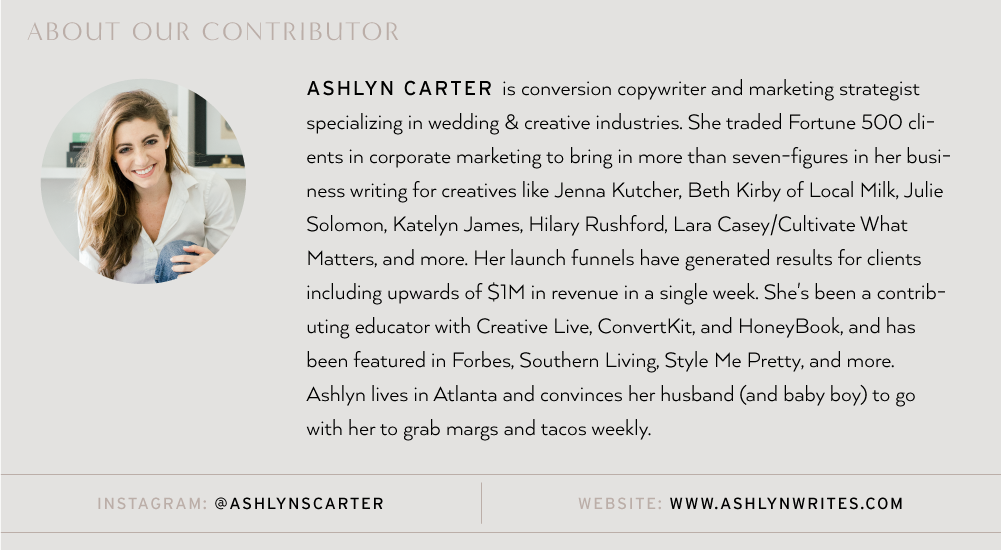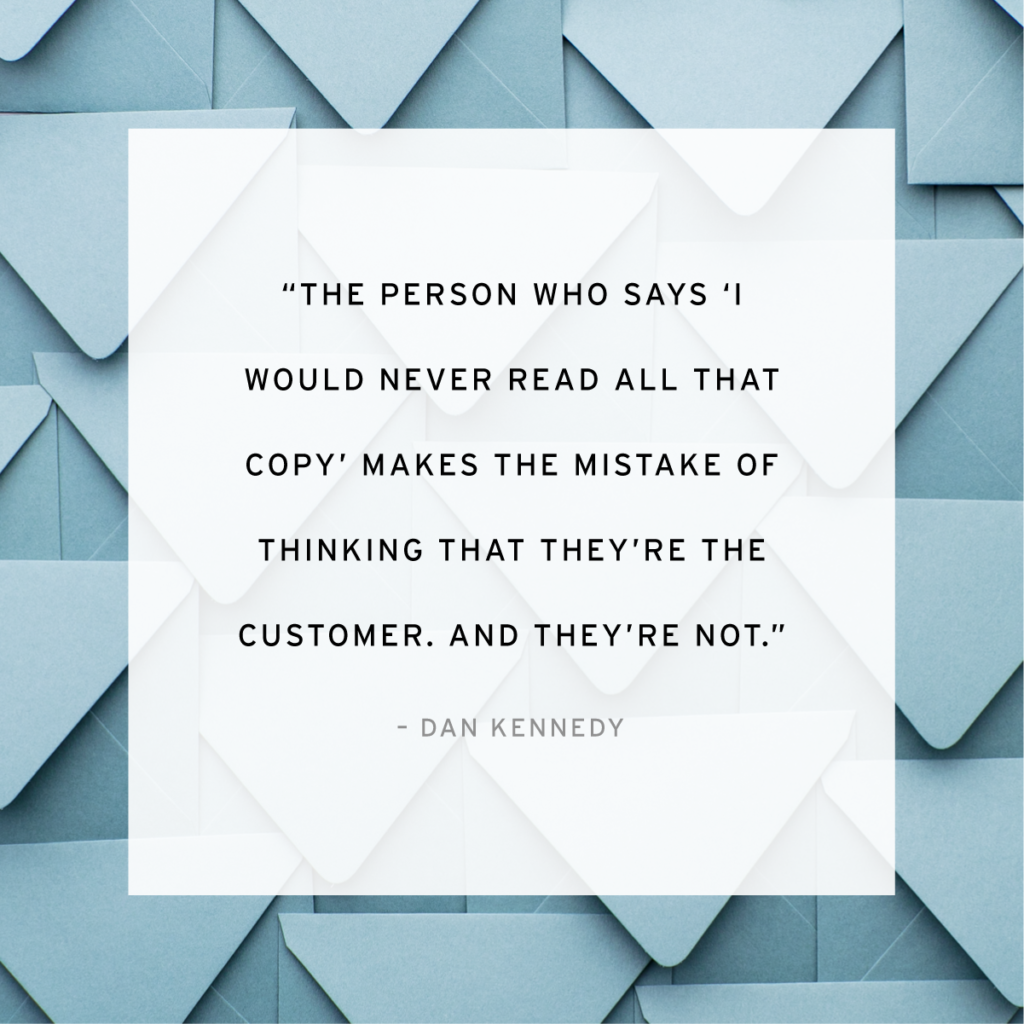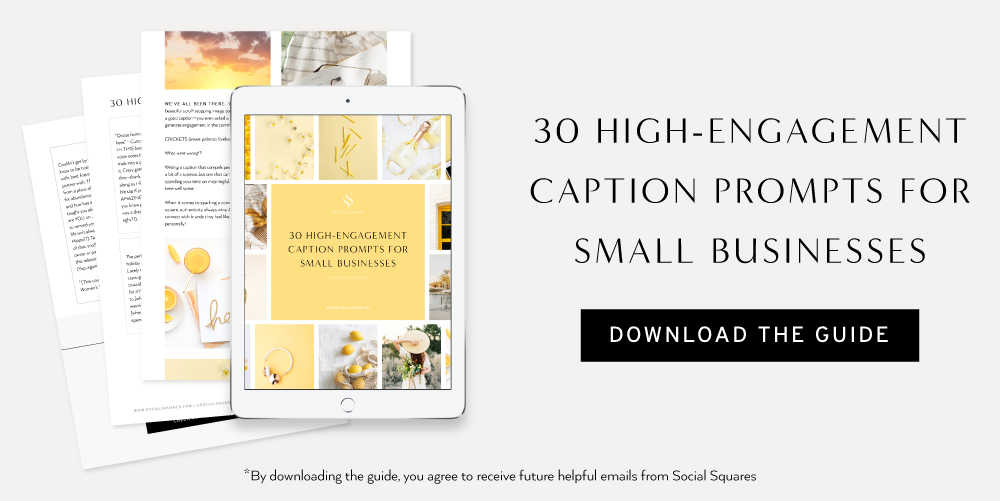“Ashlyn, this photo has nothing to do with the copy—it’s not furthering the message you’re trying to communicate.”
^^ Boom. Got that dose of (much-needed) tough love from an artistic director who was supporting my brand on some custom stock imagery, and boy, did it hurt so good.
She was dead right. ????
She reinforced the idea that—whether it’s for a website or social media—you need to curate imagery that further PUSHES the narrative you’re trying to tell, rather than plugging in pretty photos where they fit.
But after you’ve created that library of stock photos, headshots, and flatlays…
…it’s time to draft your captions.
I’m a copywriter. A words girl. I get insecure about my photos (see story above). I have learned more about photography and styling than I EVER dreamed I would as I’ve built my business, and it’s been so fun!
But, over time, I’ve learned from my Instagram queen clients like Beth Kirby of The Local Milk, Jenna Kutcher, and Julie Solomon … I’ve been on the inside of so many of their courses prior to writing sales copy that I’ve picked up a tip or two.
I heard one time that college freshman don’t want the dean of students to lead them around, they want the sophomore, so consider me your sophomore: here are 5 hacks to writing better Instagram captions.
SIDENOTE: My goal is to give you useful tips that go beyond the algorithm. I tried to think through 5 tips that have worked for me writing captions since I started my business, but also tips that worked well back when I helped businesses show up on Instagram in corporate marketing. Sooo … yes. I hope these help, no matter what month it is and what the algorithm is up to, wink.

TIP 0: LEARN TO MEASURE
Ok, let’s back up a bit: data dictates borderline any marketing decision, right? A pinch gut, a lot of creative incubation, and then a data check so we can measure what works (and what flops!).
My client Julie, mentioned above, is a publicist and influencer marketing teacher, and she taught me that when brands look to partner with influencers or microinfluencers on Instagram, they’re looking for 1% at LEAST on engagement, hopefully 2%.
As of time of writing and recording, I hit around 3.28% (p.s. Look into Iconosquare if you’re wondering what your engagement stats are).
TIP 1: HOOK ME BEFORE THE FOLD
Some of us write long captions (me!) and some of us write short captions, but unless you’re just typing a few quick words, you’re going to have copy bump after the fold.
(They’re going to have to click “more” to see the rest of your post.)
SO, what that means for me as a copywriter is I need to treat this real estate like I do any words I’m trying to get someone to read—I need to lead with the hook! This could be totally arbitrary, but at least on my account, when I try to bake in pertinent details before the line break and give enough info to hook them and have them keep reading, I see that people actually read.
This works kinda the same way that writing headlines on your website goes.
Related: How to Write Headlines that Sell on Your Homepage
When I front-load my captions and get to the good stuff first, I see better results (people actually click and read the caption).
TIP 2: TYPE IT ON A DESKTOP OR LAPTOP COMPUTER
I have such a clearer head if I get myself OFF my dang phone when drafting Instagram captions for my business.
I use the Notes app, but you can use any tool—Evernote, Google Docs, etc.—that you like. There are a few reasons I do this: First, I tend to make less spelling and grammatical errors, and secondly, I can batch type a few captions at once.
TIP 3: BREAK UP YOUR TEXT & MAKE IT EASY FOR ME TO READ
I get twitches when I look at a caption that I want to read and my eyes start to swim and cross between line after line of copy.
And then I get tired and just keep scrolling.
People DO read long things online.
They read them if they’re digestible and easy to consume.
If you’re comfortable with (a) knowing you’ll have some skimmers and (b) having a bit of a narrative in your caption, then a long caption works JUST fine …
… as long as you break it up.
Break your captions up with line breaks, whether it’s an actual line break, an emoji, a black bar, or anything else you like the aesthetic of.
I know it’s hard to get that line break in the Instagram app itself (at least it is for me), so here’s the method I use when I can’t get the copy/pasted caption from my Notes app to lay just so.
[⠀⠀⠀⠀⠀⠀⠀⠀⠀]
⬆️⬆️⬆️ That guy. I copy/paste those spaces that are between the brackets (I just keep it in a Note on my iPhone) and paste it in the caption spot.
TIP 4: HOOK WITH STORY TOLD IN YOUR BRAND VOICE
Before I dig into practical tips for telling a story in your Instagram captions, a note on brand voice: I talk about it a lot. I created a whole 9-page freebie printable on it. I made an entire quiz on it. ????️
But you can’t just skirt by on your brand’s unique voice, and I think sometimes small business owners think that’s all copywriting is.
One of the other elements you need to lace in is storytelling.
Related: The Quick-Start Guide to Story: 24 Ways to Tell Story in Your Small Business
“Tell stories that tell them about the person behind the business, stories about your own journey, and give them useful tips & advice in your area of expertise,” my client Beth at Local Milk said. “When we write about real things and get personal, we create community. We are all struggling with something, and there’s no better way to connect than to get transparent about what YOU struggle with. Perfection is overrated! Share from deep within you to connect deeply.

When I was doing research for this blog, I tried to think of WHAT I’m doing in captions when I tell a story or give flavor … and I realized I try to add in 2-3 sensory words/phrases or anecdotes that paint a picture.
Describe touch, taste, sound, sight, emotion, feel. Get specific. Don’t just say Tex Mex. Say salty corn chips dunked in guacamole washed down with tart margaritas.
Whether it’s how something smelled or tasted, the noises we heard or the backstory to the image or the people in it, I always try to punch in 2 (shorter caption) or 3 (longer caption) quips that add texture and interest.
That’s my challenge here! See if you can pepper in 2—maybe 3—sensory or story tidbits. If that sounds weird, just think about when you’re talking with your friends and trying to explain something. Story naturally is a part of our interactions and communication, so that brings me to …
TIP 5: EXPERIMENT WITH LONG AND SHORT CAPTIONS.
When I’m editing my captions (and I tend to be on the long side, I’m fine with it), I open up my text messages, pull up a new text to my best friend, and paste in the caption. If it looks too gargantuan/cerebral/bizarre for a text message, it’s probably too out there for Instagram.
Not scientific, just what’s worked to get me engagement (well, I guess that is scientific then because I look at stats).
The “best practices” for how long your captions should be are what works best for YOUR engagement and audience.
“Good Instagram captions come in all shapes and sizes, from short and sweet to a longer, in-depth stories (an Instagram caption can be as long as 2200 characters). As long as your audience finds it engaging, you’re doing great!” – Later
So, experiment! Post long ones, post short ones, and see what tends to get you an uptick. What feels more “you.” What lets you naturally be social on the app.
Like I said earlier, I am NOT an Instagram expert or teacher—I’m a marketing writing teacher and expert. A lot of what I’ve learned about Instagram comes from my clients and what I’ve tested as I’ve built my business.



Comments +
Comments —